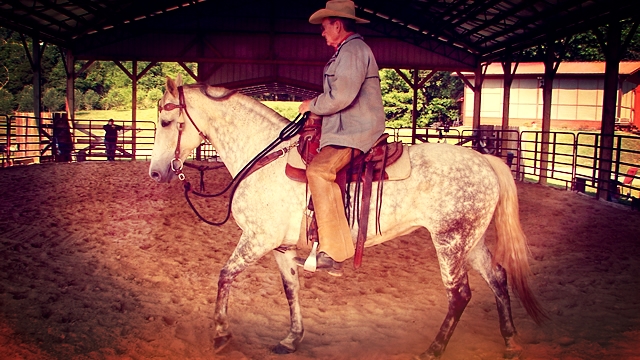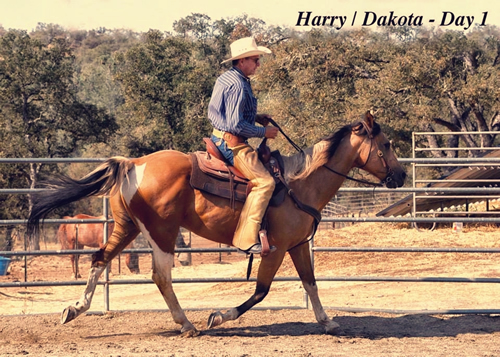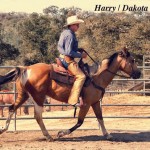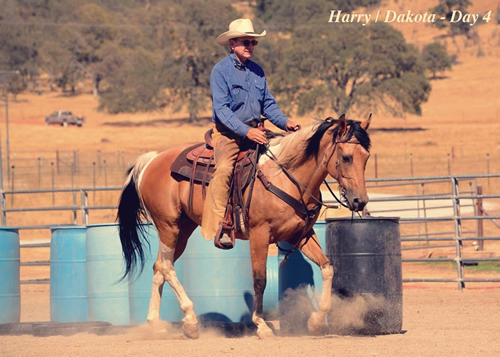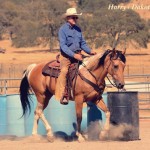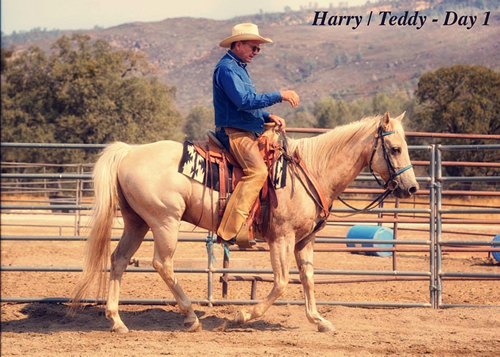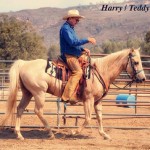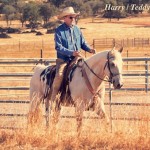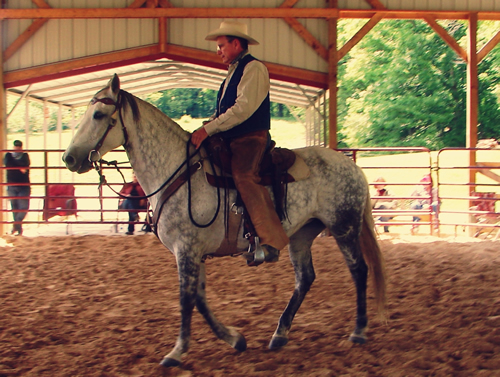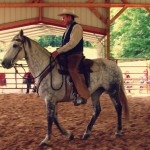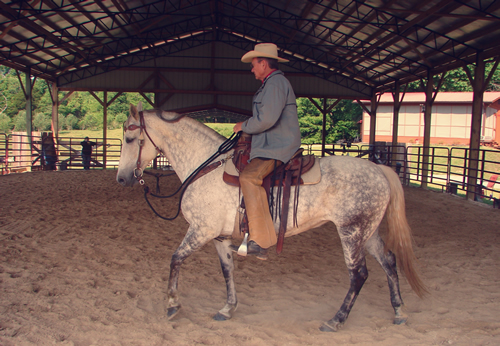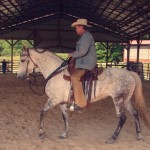For more on Harry Whitney and his clinic schedule visit: www.HarryWhitney.com.
This article originally appeared in Eclectic Horseman Issue No. 83
“Go!”Harry Whitney encouraged the horse.
“Okay, going,” the horse replied.
Screech! went the brakes to the horse’s surprise; then a few backwards steps; then a moment with the clutch pushed in as Harry and the horse hovered there exchanging feels.
“Now go, but not like that,” Harry said to the horse from the saddle.
“But I have to go like that; that’s how I go!” replied the horse, indicating his belief that with a rider, head upwards, withers crashed downwards, tightness throughout his top line, and tail swishing sharply were essential elements to a horse going.
“No you don’t,” said Harry, putting a little firmness on the reins and got another snarky, head snaking backwards step. “Get that sorted out. You CAN go relaxed.”
And the gelding did, too. He did go relaxed. Harry insisted on it, offered it, expected it, and it got better, and better, then springier and more collected, and inside of forty-five minutes you’d swear it was not possible that the horse’s posture under him could change to the point that it made it seem his conformation was different—but it was so—I saw it! And, it wasn’t the first time I’d seen it either.
Anyone familiar with my books knows I’ve spent ample time at Harry Whitney’s horsemanship clinics over the years. I’ve learned tons and have had the blessing to witness all manner of horse problems improve with Harry’s patient guidance. But still, I marvel to watch Harry ride horses. I sit perched atop a round pen panel when he climbs in the saddle and get so close he brushes right past me as he rides along the rail to be as close to on the horse with him as I can be. Still, I am astonished at what transpires between Harry and horses and wish to capture what I can of it to take home and recall when I ride my horses Jubal or Festus, or any horse.
I’m not alone in my auditing ambitions when it comes to Harry’s clinics. Many serious students applaud when Harry enters the pen or arena to ride a horse. There’s just something profound that happens…that Harry gets going with a horse that the rest of us struggle with.
2014 was a special year for us aficionados of watching Harry ride clinic horses—it was the year he put on two “Six-Day Intensive Format” clinics. My above observations came from the journal I kept during the inaugural one held May 17-22 at Mendin’ Fences Farm in Rogersville, Tennessee. The second (which I was unable to attend), was held September 20-25 at On The Way Ranch in Copperopolis, California.
A Tale of Two Clinic Formats
To explain the six-day intensive clinic format and how it came about, it’s helpful to have some background on Harry Whitney’s main clinic format since it already was unique to the clinic scene. The mainstay of Harry’s clinics for a couple of decades has been his signature five-day clinics. This format provides five full days of clinic, usually breakfast is served at 7:30 a.m. and the day runs until it’s done. Everyone, riders and auditors alike, are encouraged to ask questions at any time. Harry keeps these clinics to a maximum of six riders to provide adequate, individual time to each horse and rider.
One of the great features of these clinics is that breakfast and lunch, and sometimes supper, are provided with the opportunity for in-depth discussions at the table after each meal. Many of my own major Ah-Ha! moments were cultivated at these table talks when the group can pick Harry’s brain with impunity.
While the five-day is a favorite, Harry, however, is forever ruminating on how to improve his ability to help horses and teach people. So last season he took his long established five-day format a step further and tried what has been coined his “intensive format clinic.”
The six-day “intensive” clinic runs like a five-day clinic with regard to timing, meals, and discussions. Aside from the extra day, the main differences are that there is a maximum of five horses and Harry alone rides all of them for the first four days, and then the riders work with their horses with Harry’s coaching on the final two days.
The idea came to Harry after he held a one-time, two-week colt starting clinic early in 2014 with six head of young Quarter Horses at his place in Salome, Arizona. The way his traveling schedule works, each year after spending much of the winter doing clinics at home in sunny Arizona, Harry hits the road for a circuit of America. The first stop is a clinic in Texas, then he travels east for four or five clinics in a row during May and June at Mendin’ Fences Farm in Rogersville, Tennessee.
“When I got to Tennessee and they heard that we’d done this colt starting deal,” Harry explains, “they said, ‘Well why don’t you do one in Tennessee for us?’”
The colt starting clinic was kind of a perfect storm, Harry says, one that he won’t likely repeat. He had the colts that needed working, all owned by his girlfriend and her sister. Also, two of Harry’s long-time students were available for the two weeks to help with the colt starting. Otherwise, there were no riders, but the 20 available auditor spots were full for both weeks.
“What I had thought about,” he explains, “was something that would be sort of like that—set up for auditors, kind of like a three- or four-day demonstration. I started mulling that over in my head because from the colt starting I got the feedback that it wasn’t so much about working the youngsters that people liked, it was more about just wanting me to work them. People get excited about me getting out of my chair and riding a horse. So, I have thought about taking the demos I have done at places that have done pretty good and people seem to get something out of it, and expanding them.”
With such strong interest in the colt starting idea in Tennessee, Harry gradually developed the idea that he could work all the clinic horses for three or four days as a lengthy demo, and then perhaps the owners could work the horses for a clinic the following week. Linda Bertani, owner of Mendin’ Fences Farm, began brainstorming with Harry on the idea and the six-day (four-and-two format) was decided on, in part because folks could participate in the full clinic with only missing one week of work.
“Whether four and two is a magic number I don’t know,” Harry says. “It’s just like these five-day clinics versus a four-day clinic [Harry does different length clinics at different places around the country]…I do know that the third day things are just starting to come together and the fourth day seems to get a little better for the horses and the people both, whereas three wouldn’t quite get there.”
Attendees Discuss the Intensives
At first, I’ll admit that I wasn’t convinced that the six-day intensive clinic format was going to be all that different from a regular five-day, mainly because Harry has no set program within the five-day format anyway. When a five-day clinic starts, anything can happen. Folks can begin any way they want to—riding, groundwork, arena, round pen, playground, trailer loading—Harry doesn’t mind, and always asks what a rider would like to work on when starting. Many times I’ve seen sessions start right in the stall with an hour spent working on the little things people miss from the first moments they go to halter their horses. Also, people regularly have Harry ride their horses anyway. I’ve seen days where Harry rode all six horses during a clinic, although that is rare, so I wondered if this new format was going to be much different overall. I was surprised just how different it turned out to be.
For me, the continuity of the first four days of Harry’s work with each horse gave an unusual window—definitely an “intensive” immersion—into what this masterful horseman can accomplish with a variety of horses working with them uninterrupted for days. Although it was a clinic setting, it made auditors out of all of us, even the rider/owners. In a way, it seemed like we were observing Harry as if he were riding these horses at home for himself, but with the benefit of asking questions and engaging him in discussion the whole time.
Pam Veach
“The thing that I really love about these intensives is to watch,” says Pam Veach. Pam lives in Washington State and she is the only attendee who made it to both intensive clinics.
“In a regular clinic, you know somebody’s working a horse and then Harry may step in for a while to demonstrate something. What I liked about this is to watch him work several different horses each day. Over that period, you can see when he has a little more time how he approaches it. Probably to some people watching, it looks like not much is happening but to me a whole bunch is happening. You can only hold on to so much, so it feels like I have a lot more opportunities to get ahold of stuff when he’s working horses that long.”
Pam made the effort to get to the California intensive clinic after attending the one in Tennessee because she loved the format so much.
“That first one was so fascinating to watch,” she says, “The changes in the horses over that period of time—I walked out of there thinking, ‘I want to do nothing but get my horses to relax.’ Harry talks about it all the time so it’s not like I haven’t heard it, but to see it over the course of four days and watch how the horse changes. He can change a horse for the better in 20 minutes. But to watch it over four days, and really see how much better that horse feels, and more relaxed, it became so clear that you always go back to that basic because if you get that right you can do anything with any horse. But you have to always go back to that. I don’t think there’s anybody else I’ve ever seen approach it that way—[before] it was more like, ‘Now we have to learn to do a spin, now we have to learn to jump.’ That is the minor stuff if you can get the horse relaxed. That really hit me hard.”
Stephanie Roundy
“What I thought made this clinic much more effective for me as a student was the way it was presented in that Harry worked all five horses himself for four days,” explains Stephanie Roundy, a regular student of Harry’s from Ione, California, who attended the California intensive clinic. “So, you have five very different horses with what appeared to a lay person to be five different problems. They all have worry about one thing or another, but they exhibited that worry in different ways—some were explosive, some were shut down, some were just carrying themselves in a very U-shaped way and stowing the worry inside. He saw that worry in each of them despite the fact that they were carrying it in different ways physically and went about helping bring the worry out and helping the horse deal with that so that then they could relax.”
Stephanie says with each horse Harry wanted to establish clarity in his communication, and that clarity fostered confidence.
“With each horse, you saw over the progression of the four days with Harry that he just kept presenting things in a very clear manner, and consistent manner,” Stephanie says. “I think the photos would show that the confidence the horses gained from that was just tremendous, whereas in other clinics, Harry might step in for 15 to 20 minutes here and there. It was really able to sink in for the horses, having Harry work them four days in a row, and then I think it stuck with the horses much more when the owners came back in for the last two days of the clinic. You saw the changes stay with the horses and owners for much longer than I see in other clinic formats.”
Connie Crawford
“For me, it’s an excellent format,” says Connie Crawford, a New Englander who rode in the Tennessee intensive clinic with her horse… Moxy. “When people get to such a level of horsemanship [as Harry has], it’s hard to see what they’re doing because it happens so small and so quick. By the time they’ve said it, it’s already happened. So for me, the intensive is useful because I can see the riding and I can see the handling, and I just get repetitive hours of watching the work done well. My horse is troubled so he doesn’t flow right from the very beginning. Harry has to work to get the horse with him, and I see that process and I see it done well.”
Another important aspect of having Harry ride Moxy extensively was that it brought the horse to a place where he was better able to help Connie improve in her horsemanship, she says.
“I’ve had Harry work with the horse and then I’d pick it up,” Connie says, “and yes, you feel the difference and that’s very valuable. [But after Harry’s intensive work with Moxy] it’s deeper in the horse, and my horse specifically is more confident about it. I don’t have to fight through so much past history to get through to lightness. It goes deeper in the horse and it sticks longer. It’s building more of a foundation in the horse of lightness and responsiveness.”
Lauren Gruber
“I thought it was amazing,” says Lauren Gruber.
Lauren is a horse trimming and lameness specialist and has been attending Harry’s clinics for many years. She lives in Tennessee and audited the first intensive clinic.
“Anytime you get to see Harry work a horse is truly a gift. I really liked that he started with the horses. In other clinics, obviously the owner starts and the horse is in a different environment and there can be a lot of struggling, especially in the first couple days of a clinic. So, because of Harry’s experience and how he is, he helps to circumvent all that. He just gets that horse’s mind present. He gets the horse feeling okay about the human relationship. Then he just gets to work. To see that five times for four days in a row is amazing. All the horses were present—they were in a relationship.”
Harry’s Thoughts
“It seems I might be failing at other clinics in getting the point across to people about having a horse mentally with you and relaxed,” Harry told me later when speaking about the intensive clinics. “The horses are not going to be relaxed if they’re not mentally there—the point is, I know I talk about it at other clinics and yet, it doesn’t seem to sink into people like at these intensives. And again, when people give us feedback, it really hit home to them that I keep going back to having the horses mentally there and having them relaxed so that they can do what we want them to do.
“When you hit on a subject—you mention it, you make a couple statements about it—but then in a regular clinic you often have to move on to helping the owner, the handler of the horse, and it doesn’t keep the continuity of the subject of where the horse is mentally, what they’re thinking, and how to progress. So that continuity from horse to horse, five horses a day, four days in a row, the same thing [getting the horse there mentally and relaxed] just keeps coming at them with all kinds of situations in the groundwork, in the riding, in a whole variety of situations. Then it begins to hit home and they see the horses start progressing rather rapidly. And there are areas that people miss that a horse might need help with or need to work on, and yet it seems that when you clean up the worry—get the horse mentally attentive and get rid of the worry—that a lot of those things cleared up and didn’t need worked on.
“I guess I don’t understand why more people don’t audit more because there’s so much that comes out.”
More From Stephanie Roundy
“Auditing in general, in a different format where you’re just auditing and you do not have a horse at the clinic,” says Stephanie Roundy, “I think you’re able to soak in more of the information because you are not worried about when it’s your turn, and when you’re going to be in the spotlight how it’s going to go, and what might happen. You can just be focused on taking in the information and observing and asking questions.
“Auditing this clinic, I think I got even more than at a general auditing because of the format of just watching Harry over and over again—the organization of the way it was presented made it far easier for me to retain the information even though I may have heard each of those tidbits of wisdom multiple times over the years. It was for me much easier to retain the information and then apply it when it was my turn on day five to go in and try it. I was able to apply it and get the changes much better than other formats that I have ridden in.
“It’s a tremendous learning opportunity. The way the intensive format was presented, Harry is working the horses but he is articulating his thought process and the reason he is doing a particular thing at that moment as he goes along. So he’s explaining it, but he’s also open to questions from anybody at any time during the clinic. It’s a very interactive process for the auditors. It’s a format that’s offered a rare opportunity to see a really great horseman share his expertise in a very comfortable setting. I think I got more out of this format than any other clinic I’ve gone to.”
Day Four
“Go!” Harry encouraged the horse, but I missed it this time—they went from standing to walking out so smoothly I never saw Harry’s ask.
Harry had done a few minutes of groundwork before mounting up, and the horse was a little mentally wayward at first. It didn’t take much, though, for Harry to get him letting go of outside things on his mind and get focused and relaxed in the arena there with him.
Harry mounted up, and off they went along the fence.
Screech! went the brakes, but the horse wasn’t surprised this time. The firmness in Harry’s reins had a meaning. Harry was saying that something needed tending to and the horse recognized it and seemed to be searching for it. Harry made a slight ask with the reins and I suppose, although it was too subtle for me to see, his body as well, and the horse’s front end stepped over away from the rail. The horse, standing up straight now and straight through his body, eased gently forward when Harry asked. They went only a short distance before, Screech!—a halt, and Harry stepped that front end over again….
There was no worry in it; no head tossing now. Over the past handful of days, Harry had the horse operating with far less tension. Now, the clinician was working on some habitual imbalances in this horse.
“You need to pay attention and see what motions go with good emotions and what motions go with sorry emotions,” Harry said to us onlookers.
That statement reminded me of the first day of this intensive clinic when Harry worked to convince this horse that he could go with a rider without being upside down and tight as a fiddle string. Only now, they were at a whole new level. Now Harry was unraveling other kinds of sorry carriage in the horse, deeper places where the gelding held worry and it presented in a form of crookedness and shoulder leaning.
It left me sorry that the fourth day had arrived. I wanted to watch Harry ride these horses everyday for at least another couple of weeks, and I wondered, if he did, just what would I be witnessing then…?
For more on Harry Whitney and his clinic schedule visit: www.HarryWhitney.com.

